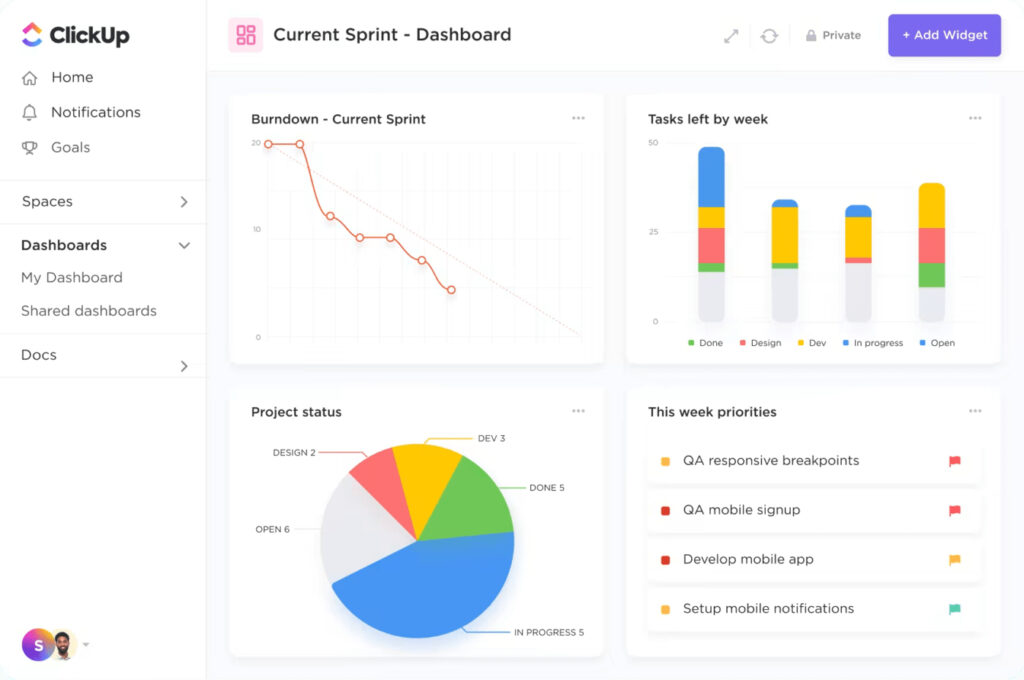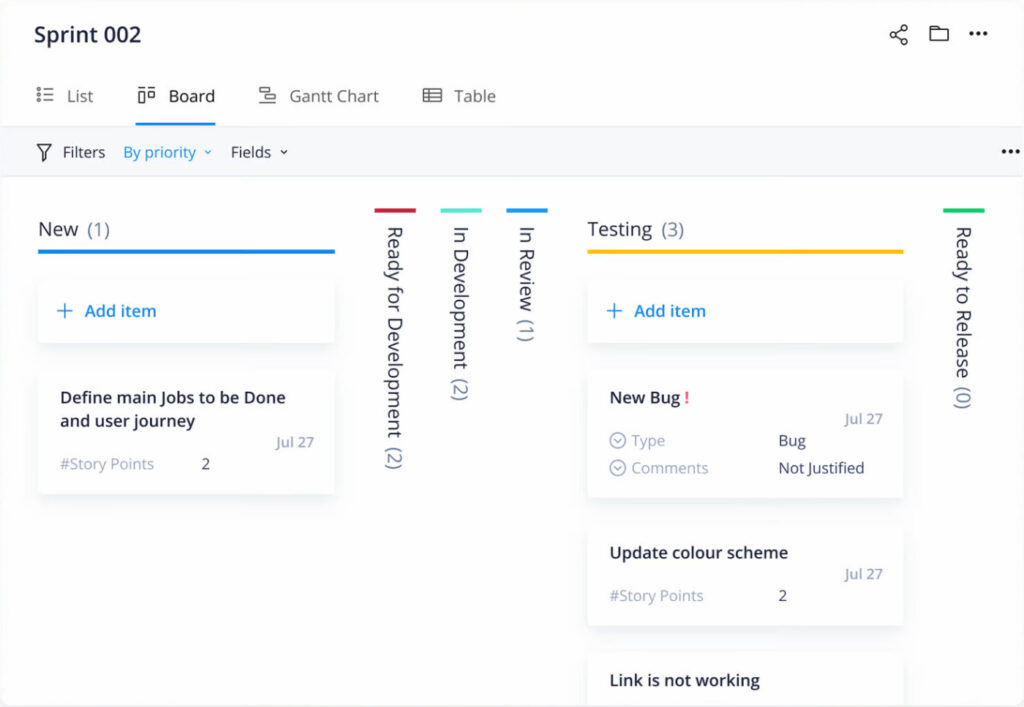Agile Project Management
Project Management
Key takeaways
In this article…
What is Agile project management, and why is it important?
Agile methodology is a collaborative, iterative approach incorporating continuous testing and change responsiveness. Each iteration involves planning, execution, testing, and constant feedback from the client, allowing for adaptation and course correction throughout the project’s lifecycle. This model is highly flexible because the course of action is regularly updated to meet the changing demands.
Agile project management, or APM, is founded on agility—the ability to move, think, and understand quickly. An Agile process helps teams manage work more efficiently, improve communication, and streamline workflows to deliver the highest-quality product.
A wide array of software solutions are available to support Agile teams. Read our guide on essential APM software features to consider when deciding.
History of Agile project management
To better understand what Agile project management is, you must appreciate its history and purpose. Before Agile came along, the Waterfall methodology was the gold standard for software development. This approach identifies problems, plans solutions, and delivers the final product. However, it required long and detailed initial documents, causing a significant lag between an application’s need and delivery.
Agile’s roots began in the 1990s when software teams explored new methods with less overhead planning, flexibility, and efficient product turnover. In 2001, 17 experienced developers discussed their beliefs about how software development should be done.
The software practitioners developed the Agile Manifesto, which outlines the four values and 12 principles of the Agile philosophical mindset for software development. The Manifesto is not prescriptive and doesn’t include specific processes, procedures, or best practices for Agile software development.
Comparing Agile and Waterfall is not a one-size-fits-all decision
Choosing between these approaches depends on various factors, including project size, company specialization, team skills, clients, and regulatory requirements. Our in-depth comparison of Agile vs Waterfall outlines the similarities and differences between the two methodologies.
How does APM work?
APM breaks down projects into small, manageable, repeatable sections called sprints. Agile teams move projects forward in short cycles with planning, testing, development, and result review steps. When a cycle ends, feedback is gathered and utilized to plan for the new iteration within a few weeks.
Throughout the project lifestyle, APM encourages customers to interact and work with the product, particularly at the end of each iteration, and provide feedback. This allows developers to refine processes to produce higher-quality results and saves time and resources by focusing on prioritization and iterative delivery.
The Agile way of working enables teams to concentrate on delivering valuable features based on demand, leading to quicker time to market. APM fosters unit empowerment by creating a culture of autonomy, ownership, and self-organization, resulting in greater motivation, creativity, and productivity.
If you’re considering using APM software or seeking more information on maximizing your chosen solution, check out our detailed guide on using Agile project management software for client work.
Phases of the APM framework
The APM framework aims to deliver quality and value, and offers a cohesive method of effective project management. Implementers divide the project into smaller, achievable milestones completed in iterations. Teams have built-in quality control segments to check the progress of their milestones after each cycle.
APM has five phases, forming a seamless, cyclical process that allows teams to iterate and refine their work while aligning with stakeholders’ expectations. Agile’s five phases create a cohesive and dynamic process that is applicable and essential for navigating the complexities of modern projects. Read about the APM framework phases below.
Types of Agile methodologies
Agile methodologies are far more fluid than traditional project management approaches. There are five distinct adaptations of the Agile methodology: Scrum, Kanban, Lean, XP, and DSDM. The right choice or blend depends on your project’s characteristics, team dynamics, and organizational context.
Core values and principles of Agile projects
The Agile Manifesto outlines a total of four core values and 12 guiding principles for teams adopting the Agile methodology. Originally, Agile methods were strictly for software development practitioners, but its core values and principles showcase how the methodology applies to any organization.
Agile core values
Agile processes underscore the importance of client communications and involvement, starkly contrasting traditional project management methods. The four core values of Agile are the following:
- Individuals and interactions over processes and tools: The human element is crucial to project management, and over-reliance on processes and tools results in an inability to adapt to dynamic circumstances.
- Working software over comprehensive documentation: Give developers what they need to complete development without overloading them with documentary requirements.
- Customer collaboration over contract negotiation: Capitalize on your customers and involve them in the process, ensuring they meet their end product effectively.
- Responding to change over following a plan: Change is seen not as an expense, but as an opportunity for review and timely course correction.
Agile principles
Agile’s four core values are supported by 12 key principles that promote flexibility and process experimentation. The 12 principles of Agile methodology include:
- Customer satisfaction is the highest priority through early and continuous launching of the deliverable.
- Welcome changing requirements even late in the development process. Harness change and use it for a competitive advantage.
- Frequently deliver or deploy a working software, product, or service for quick adaptation.
- Business owners, clients, and other project stakeholders must collaborate daily throughout the project.
- Make motivated individuals the cornerstone of your project and give them the support and tools they need to complete the job.
- Face-to-face interaction is the most effective way to convey information.
- The final deliverable is the primary measure of progress.
- Project stakeholders, such as sponsors, developers, and users, must maintain a constant and sustainable work pace.
- Enhance agility by paying continuous attention to technical excellence and good design.
- Simplicity—the art of maximizing the amount of work done—is crucial to success.
- The best requirements and solutions emerge from self-organizing teams.
- Teams must reflect regularly on how to become more effective and adjust their behavior accordingly.
Pros and cons of Agile project management
Agile project management promotes effective communication, shared comprehension, and collaborative problem-solving among team members, stakeholders, and customers. However, despite its advantages, it may not suit teams requiring heavy documentation and definite resource planning.
Analyzing the positive and negative aspects of APM can help gain a comprehensive understanding of this method’s potential benefits and drawbacks. Here are the advantages and disadvantages of Agile project tracking:
Advantages of Agile
- Flexibility: Agile methodologies allow for changes and iterations throughout the project, accommodating evolving requirements and market conditions.
- Faster time to market: Enable faster product release by delivering working solutions in short iterations, allowing organizations to respond quickly to market opportunities.
- Customer-centric approach: Emphasize collaboration with customers and stakeholders, ensuring that the delivered product meets their needs and expectations.
- Enhanced communication and collaboration: Promote frequent and transparent communication, fostering collaboration among team members, stakeholders, and customers.
- Continuous improvement: Encourage regular retrospectives, enabling teams to reflect on their performance. Implementers can identify areas for improvement and make changes to enhance productivity and product quality.
Disadvantages of Agile
- Lack of predictability: The methodology’s adaptability makes it challenging to estimate timelines and budgets accurately, especially in complex and dynamic projects.
- Requirement volatility: Agile’s iterative nature may lead to evolving requirements, requiring significant adjustments that potentially impact the project’s scope and timelines.
- Resource management: The approach requires dedicated and cross-functional team members, which can be challenging in organizations with competing responsibilities or limited resources.
- Cultural and organizational alignment: Implementing Agile methodologies may require a cultural shift and buy-in from stakeholders, which can be challenging in organizations with a hierarchical or rigid structure.
- Documentation and reporting: Focusing on delivering working software may result in less emphasis on comprehensive documentation and reporting. This may be necessary for certain regulatory or compliance purposes.
Examples of Agile project management
Agile is no longer limited to software development and is now used in different industries, including IT, manufacturing, and marketing. To better appreciate what Agile project management is, here are some examples of the Agile process applied in business.
FAQs
About the author





